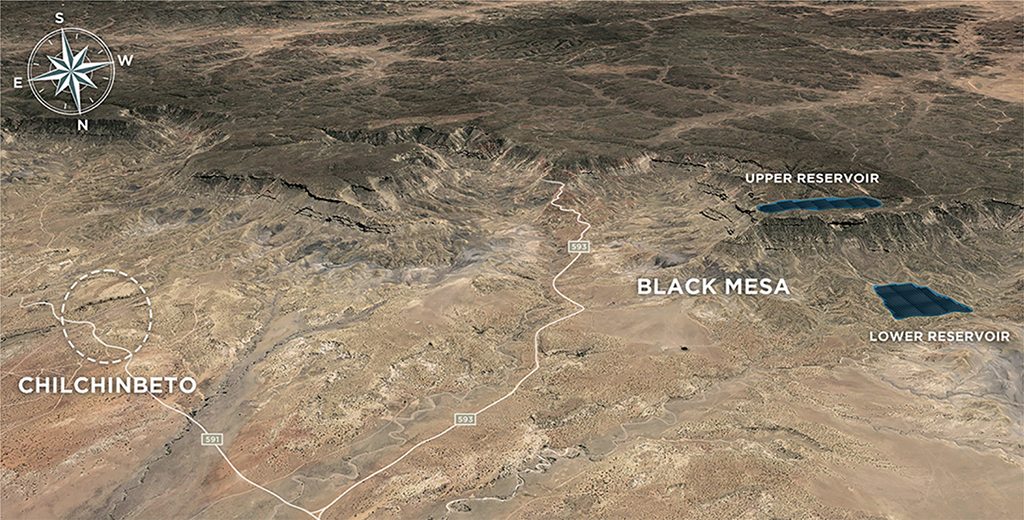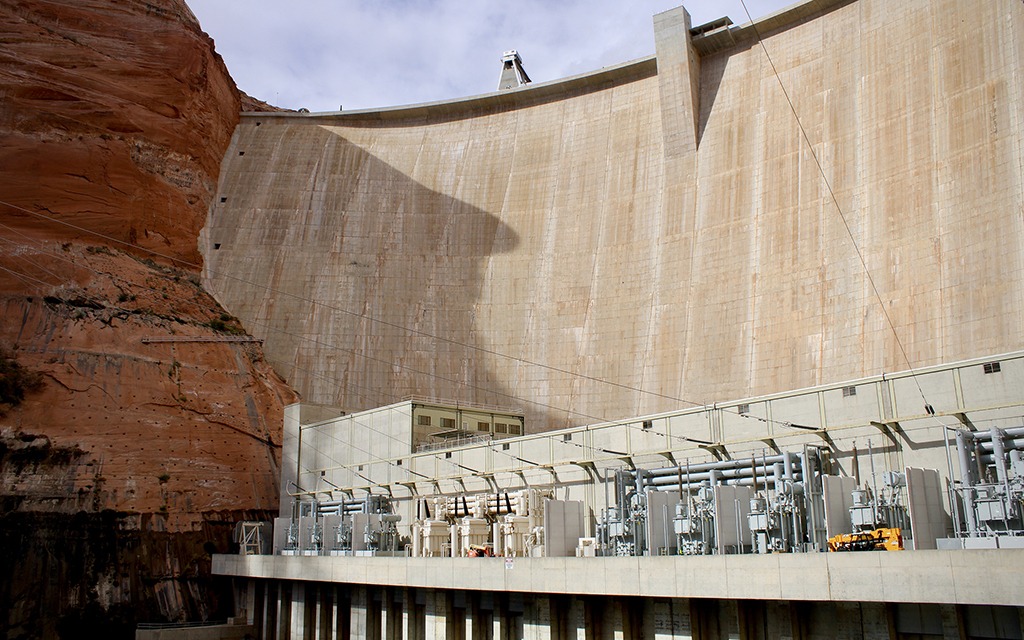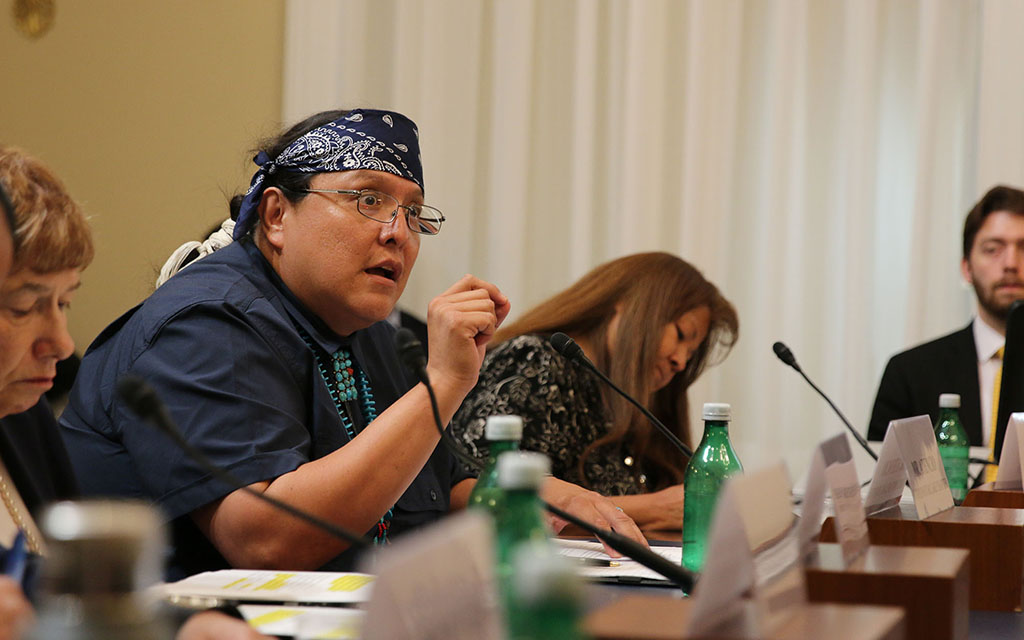
A view overlooking the rim of Black Mesa in September.. Plans for a pumped hydropower project in the area, which opponents say is a critical habitat for several protected species, like the Mexican spotted owl and golden eagles, among other concerns. (Photo by Chris Clements/KSJD)
WASHINGTON – When Adrian Herder saw the plans for proposed hydropower project on the Navajo Nation’s Black Mesa, he was shocked by the “outrageous” 450,000 acre-feet of water the project would reportedly use.
“Which is also kind of scary, too, especially given that we’re from such an arid region here on Navajo,” said Herder, media and community organizer for Tó Nizhóní Ání – or Sacred Water Speaks – a Diné-led environmental nonprofit.
Developers agree it would be scary – if it was right. But Denis Payre insists that the Black Mesa Pumped Storage Project – which is still years away from approval, much less construction – will use only about 3,000 acre feet of water while generating clean, renewable energy.
“The reason why Sacred Water Speaks reacted like that is probably because the process can be confusing if you’re not familiar with it,” said Payre, president and CEO of Nature and People First Arizona, the company that has started the permit process on the project. “They are not permits to build, they are just permits to survey.”
Crossed signals are among the many reasons that opponents are pushing back against the project, which they fear will deplete the region’s aquifers and repeat a history of developers ignoring tribal sovereignty.
The Black Mesa project may be the most controversial of a number of pumped hydropower generation proposals that have sprouted in Arizona recently.
Conventional hydropower, like that generated at Glen Canyon Dam, uses water flowing downhill to turn a turbine to generate electricity. But pumped hydropower systems make that a closed loop by using two reservoirs: Water falls from the higher to the lower reservoir at night, generating power in the process. It is pumped back uphill during the day, using less energy than had been generated, and the process is repeated.
Proposals for such projects have become increasingly popular in Arizona, according to filings with the Federal Energy Regulatory Commission. FERC is currently considering eight preliminary permit applications in Arizona for projects with a potential to generate 9,942 megawatts of electricity, and has approved preliminary permits for another seven, which could generate 6,150 megawatts.
“We’ve noticed in the last what, like 18 months, how the number of projects have been proposed and they keep coming up,” said Jen Pelz, water advocacy director for the Grand Canyon Trust. “And every time we think that they’re going to stop, there’s like a new project.”
A preliminary permit from the FERC only allows developers to investigate the proposed area for a project. It also gives the applicant priority to file a license application for the project, if approved. It is not permission to build.
Nature and People First Arizona applied for a preliminary permit on Oct. 5, 2021. The FERC posted a notice in the Federal Register on Nov. 7, 2022, saying the company’s application had been accepted and was open for comment until January 2023.
The Black Mesa application envisions up to three pumped storage loops that could generate up to 6,000 megawatts of power, but Payre said the company plans to start with just one of those three, if it gets approved.
“The purpose of these projects in the Black Mesa area is to serve essentially utilities in the West, mostly in Arizona, but potentially beyond that,” Payre said.

A map made by Nature and People First shows an area where some of the reservoirs could be located, near the Chilchinbeto Chapter. The permits the company applied for wouldn’t permit any construction or land-moving activities to take place yet. (Map courtesy Nature and People First)
He said the project could generate new tax revenue and create “1,000 jobs during the construction phase and about 100 indirect and direct jobs afterwards for the next 50 years or so.”
Nicole Horseherder, executive director of Tó Nizhóní Ání, said the company should be focused on the project’s potential impact on the environment, not its economic potential.
“I am insulted by a company coming in in the name of economic development and proclaiming to be providing something that’s going to bring about … jobs and some economic benefit to the community, when we know that we’ve got to do the opposite in order to allow the aquifer to recover,” Horseherder said.
She and others charged the company with failing to consult with residents and tribal authorities before proceeding with the project.
“You’ve got a company that’s coming in proposing to do something and doesn’t have the tribal consent to actually move forward with this,” Horseherder said. “They just went straight to FERC and filed their project there and they’re awaiting permits to do their studies,”
Payre said his company did meet with community groups in February, and he believes “that after consulting with this NGO (nongovernmental organization) and a few others, we found the right option to make this project widely acceptable by local communities.”
Among the changes was one suggested by Daniel Higgins, a hydrologist advising Tó Nizhóní Ání, who said the company should use water from the lower-quality C Aquifer, which extends beyond the Navajo Nation boundaries, and not from the N Aquifer, which has good quality drinking water.
The project will use 3,000 acre-feet from the C Aquifer, compared to the 105,000 acre-feet currently drawn from it to cool three carbon-dioxide-emitting power stations, Payre said, “So it’s going to use a far lower quantity of water. And this water will be used for a very clean project.”
He also said the project would have “a far smaller footprint and far smaller quantity of water” than what was cited in its preliminary permit application. “And that probably is where the misunderstanding comes from, you know, the actual footprint of the project is going to represent only 6% of what was filed in the PPA,” he said.
But Herder had a different take on the meeting. He said “developers pretty much pitted the community members against one another, deciding that these are people that … don’t want progress on that when we were just concerned about the impacts on water within our region.”
Horseherder said Nature and People First “haven’t even taken the proper steps in engaging tribal communities.”

Traditional hydropower plants, like the one in Glen Canyon Dam, generate electricity by building a reservoir behind a dam that is released to power a turbine. Pumped hydropower does away with the dam by recirculating water at specific times. (File photo by Alex Hager/KUNC)
“So it’s problematic on many levels and it’s very colonial in its approach and we just totally reject this project,” she said.
“This is the history of companies on Navajo … they come in and they think they have the answers to our problems and they don’t,” Horseherder said. “They think they know what’s best for us and they think they know what’s best for the use of our resources and that just needs to stop.”
Of the 14 other pumped hydropower projects proposed in the state, few have seen the type of pushback that the Black Mesa project has received.
Before Rye Development applied for a preliminary permit for another hydropower pumped storage project on the Navajo Nation on June 12, it consulted with the Navajo Nation and got a letter of support from the Navajo-Hopi Land Commission. There was essentially zero blowback to the Rye project and the FERC accepted it for public comment on Sept. 20.
Pelz said her experience is “once you get to the permitting process, things move pretty quickly.” If Nature and People First had done such consultation before filing for its permit, she said, it may not have experienced the pushback that they are.
“The concern is that from a tribal sovereignty perspective, you know, the tribe should be the first to know about these projects and should have the opportunity to understand and to learn what the projects are before,” Pelz said.


